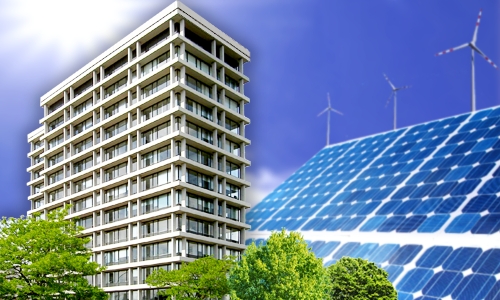Can Photovoltaics make a useful contribution to the Energy Mix in Hong Kong?
Dr Ian Ridley, Associate Professor, School of Energy and Environment, City University of Hong Kong.

In January 2017 the Hong Kong Government released its Climate Action Plan 2030+, giving details of targets to reduce the carbon intensity of the economy by 65-70% by 2030. In the short term the strategy to achieve this reduction will start with transitioning from coal to gas as the main source of electricity production. In the medium and long term the government is seeking to promote the use of renewable energy such as wind and solar.
At present in Hong Kong there are very few installed Photovoltaic (PV) panel systems. This raises the question can Photovoltaics make a useful contribution to the Energy Mix in Hong Kong? What is needed to promote the use of PV in Hong Kong and stimulate growth in this sector?
In many parts of the world the installation of PV systems in buildings is common place. 10% of all houses in Australia have been fitted with PV. In Europe there are moves to introduce regulation that will see all new houses fitted with PV systems. The price of production and installation of the systems has decreased rapidly over the last 10 years and in many locations PV is regarded as a mature and cost effective technology to increase the energy efficiency of buildings and reduce CO2 emissions. In Australia PV systems and installers advertise heavily on TV and the internet, and the decision of a homeowner to install a system is primarily driven by saving money not by being “green”. A 3kW peak system can be installed, after receiving a government rebate for approximately $25000 HKD, and meet approximately 75% of the demand of a typical house, paying for itself in 5 to 7 years. The market is very well developed with online tools allowing prospective clients to size a system, and calculate performance and payback times.
Can this success be repeated in Hong Kong? The location of Hong Kong at 22 degrees above the equator means that we have a good solar resource. This is slightly reduced by the humid and cloudy climate but a 1 kW peak PV system in Hong Kong can still produce an annual yield of 1200 kWh, which is greater than can be achieved in Northern Europe and not much smaller than in Victoria Australia.
There are of course some fundamental specific differences here in Hong Kong that explain why the installation of PV is lagging behind that of Europe, Australia and the US. Hong Kong is a densely populated highly urban location where the majority live in high rise multiple occupancy apartment blocks. The model for PV installation that has been adopted in other locations where PV is installed on individual householder roofs cannot be replicated in Hong Kong. The second difference is the present structure of the electricity supply market and regulatory framework that results in an effective duopoly of supply and limits the possibility of PV owners selling the electricity that they produce.
The lessons from Europe and Australia suggest that if PV installation is to be successfully promoted and incentivised a regulatory framework that allows net metering and initially favourable feed in tariffs is required. This stimulates demand and allows the installation industry to grow, quickly reducing installation costs and bringing down the price of equipment, which allow initial subsidies to be reduced then eventually withdrawn. Care must be taken to avoid a boom and bust cycle by the introduction of overly generous initial subsidises that are unsustainable which when too quickly removed can adversely affect a young industry.
In the Hong Kong context innovate solutions are needed that will allow PV system to be fitted to multiply occupancy buildings. Energy Service companies that rent roofs or install panels on building façades will be required. The building stock in Hong Kong is ageing, there are now many high rise buildings that are between 30 to 50 years old and will require maintenance and refurbishment. The facades of these buildings will inevitably require repairs; cement renders need patching and repainting, ceramic tiles replacing, window frames maintained, air conditioning units upgraded. An imaginative regulatory framework is needed to integrate building repair and maintenance cycles, with programs that promote the installation of PV panels.
The creation of an environment that will lead to the widespread installation of PV requires a truly interdisciplinary approach with input from experts from many diverse fields. Scientist and Engineers must work to improve the efficiency and reduce cost of production of PV systems. Property developers and building owners will need to work in cooperation with a new sector of Energy Service companies and Financiers that can deliver the installation and maintenance of PV systems in high rise buildings. Urban planners and Engineers need to better understand and predict the solar potential in a dense urban environment. Policy and Regulatory experts must produce a framework that will balance the needs of many stakeholders, utility companies, consumers and society’s need to transition to a low carbon future.
There are evidently challenges to the widespread installation of PV in Hong Kong, but there are substantial opportunities to create a sustainable and profitable green energy supply sector that will employ a larger number of people and add to wealth creation. Twenty years ago many people would have doubted that PV would be cost effective or desirable in Australia and Europe, but it has emerged as a successful industry contributing to the supply of more environmentally friendly energy. With the correct approach significant steps could be taken towards repeating this success story in Hong Kong.